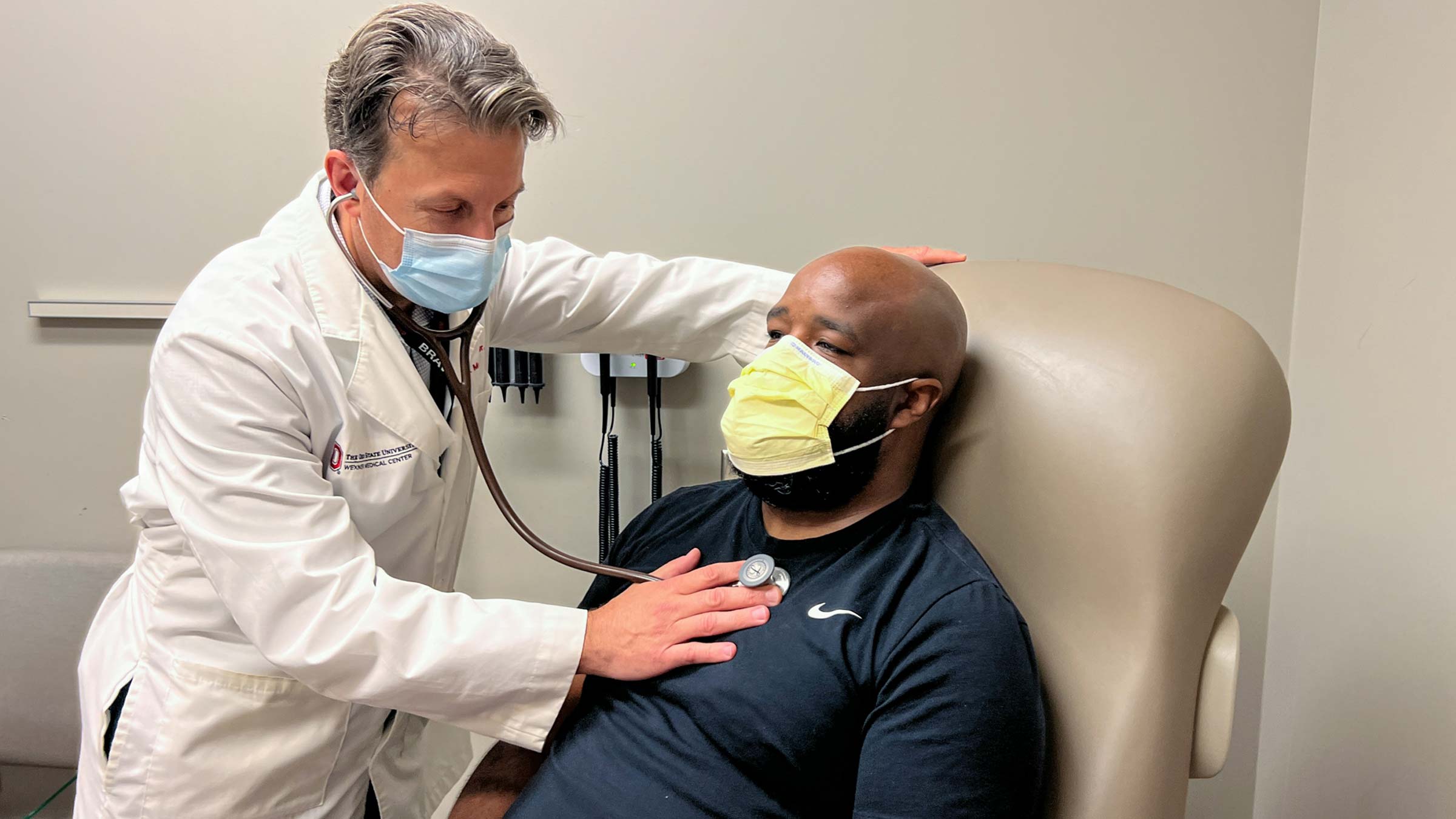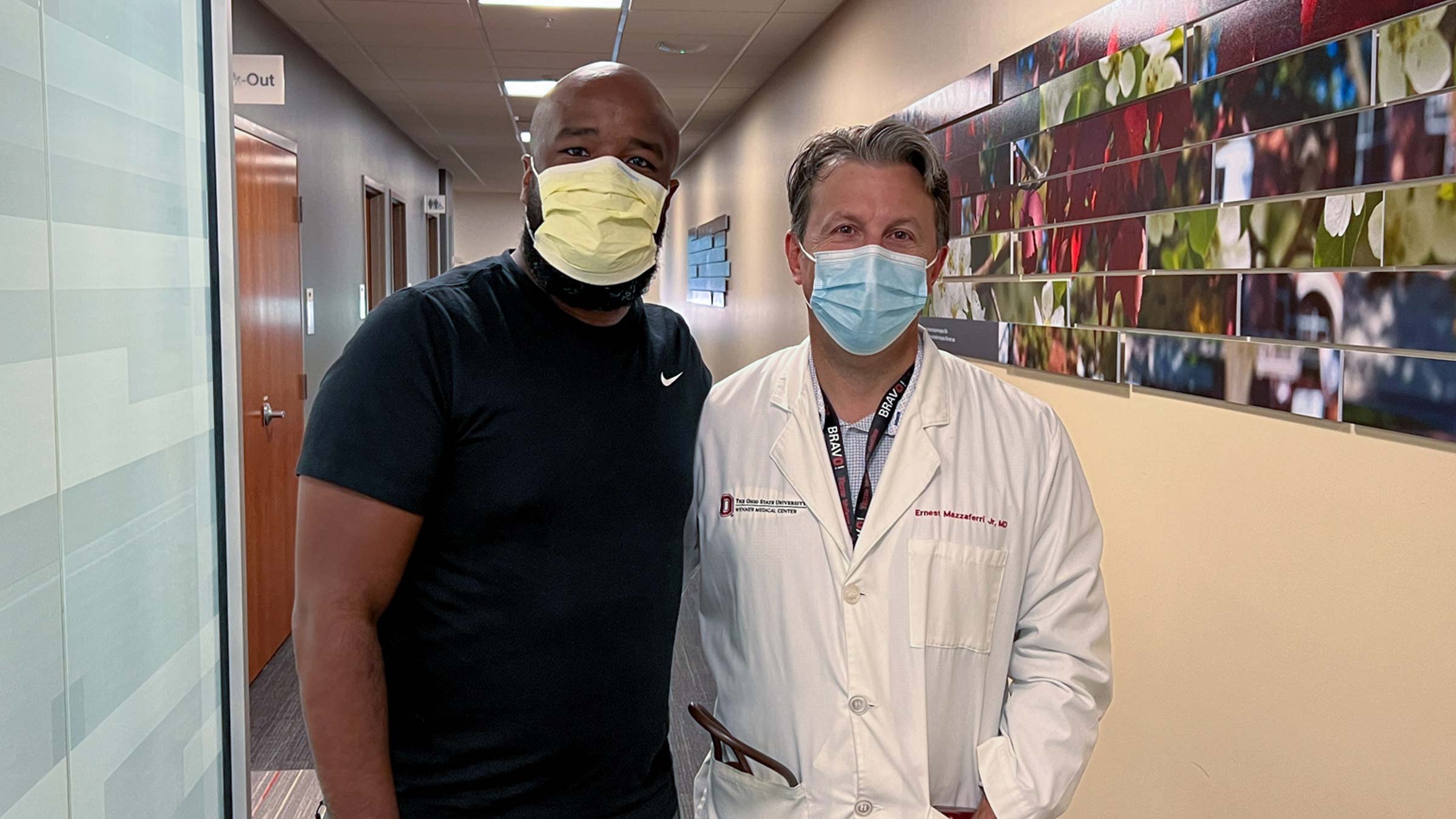
Marcus Wright was only 27 when he suffered his first heart attack.
At first, he and doctors thought it was a bad case of indigestion since he was young, healthy and nothing abnormal showed up on his electrocardiogram. “Let’s do some blood work just to make sure you’re OK,” the emergency department doctor told Wright. Twenty minutes later, the doctor returned with news that stunned Wright.
“You’re not going anywhere. You’re having a heart attack right now,” Wright recalls the doctor telling him in 2008.
Wright’s condition puzzled experts who examined him for almost a week in the hospital and even did a heart catheterization but didn’t find anything. He was eventually referred to Ernest Mazzaferri Jr., MD, an interventional cardiologist at The Ohio State University Wexner Medical Center’s Richard M. Ross Heart Hospital and a clinical professor of Internal Medicine at The Ohio State University College of Medicine.
It was a referral that would lead to the discovery of rare genetic mutations that had never been identified before and that could cause severe early onset of coronary artery disease, the most common type of heart disease in the United States. The discovery is leading to a better understanding of how cholesterol functions and the possibility of developing safer therapeutics for the 94 million Americans with high cholesterol.
“When I met Marcus about 14 years ago, he looked like a linebacker for the Ohio State Buckeyes. He was super fit and active. He was the last guy that you would ever think would have this kind of disease.” Ernest Mazzaferri Jr., MD, co-interim director of The Ohio State Wexner Medical Center Heart and Vascular Center
“His cholesterol and inflammation numbers looked pretty good and there was no family history of heart disease at that point, so it didn't make sense why somebody like him would have such advanced disease.”

The mystery of Wright’s heart condition deepens
Despite optimal medical therapy, Wright continued to have symptoms and needed multiple heart stents, which are expandable metal coils placed in a blocked blood vessel to keep the arteries open. “Listen to your body” was a piece of advice from Dr. Mazzaferri that Wright kept in the back of his mind as his heart problems continued to advance.
“The best thing Dr. Mazz says is treat it like your grandfather. He says, ‘I’m not saying that you're old as your grandfather, but if something hurts, you can't push through it. I need you to go to the hospital and just get checked.’ Understanding that took me the longest time,” says Wright, who lives in Hillard, Ohio.
When both Wright’s mother and younger brother were later diagnosed with severe coronary artery disease, Dr. Mazzaferri suspected there was a genetic link. He decided it would be a good case for Ohio State’s JB Project, which is funded by philanthropy and brings together clinicians and scientists to decipher the root cause of highly unusual cases involving coronary artery disease, arrhythmias and heart failure.
“Marcus became the first patient I ever presented to our genetic scientists and I said, ‘Nobody can figure out what's wrong with this young man. I need your help to understand what's wrong with him,’" says Dr. Mazzaferri, who holds the Charles A. Bush, MD, Professorship in Cardiovascular Surgery in The Ohio State University College of Medicine.
16 and healthy one minute, in dire need of a heart transplant the next

Researchers look to genetics for the answers
A team of researchers led by Sara Koenig, PhD, assistant professor of Internal Medicine in the Ohio State College of Medicine, conducted genetic sequencing of Wright’s DNA and identified unique genetic variants that were causing his advanced disease. To better understand the potential implications of these genetic mutations, Dr. Koenig expanded her study, identifying the same mutations in his mother, father and brothers.
“This gene encodes a receptor for HDL, which is classically referred to as your good cholesterol,” Dr. Koenig says. “We hypothesize that good cholesterol does not function as well in these individuals as the general population.”
The researchers determined that Wright’s genetic variants prevented his good cholesterol from effectively clearing out his bad cholesterol (known as LDL), leading to his advanced coronary artery disease. Their findings were published in the American Heart Association’s Circulation Research.
“The identification of these specific variants in Marcus and his family and knowing that they are causing coronary artery disease sheds lights on a new pathway that we can approach for cholesterol mediated therapy,” Dr. Koenig says.
Working on a possible treatment for high cholesterol
Researchers examined 788 drugs approved by the U.S. Food and Drug Administration for various diseases to narrow down which ones may promote a healthy HDL function. They are now working on developing different diagnostic tests and a new therapeutic drug that may provide an alternative option for those living with high cholesterol.
“Genetics play a really important role in cholesterol and cardiovascular disease. Even if you’re doing everything right by exercising and eating the right foods, some people are just predisposed to high cholesterol and coronary artery disease, which is exactly what happened to Marcus,” Dr. Koenig says.
“The issue with statins, which lower your cholesterol, is that they’re not 100% effective. We’ve identified a handful of drugs that promote the good HDL pathway or reverse cholesterol transport. Now we are investigating these drugs in animal and human cell models in the hope that we can identify how they affect the pathway and develop more targeted therapies.”
Wright didn’t hesitate when asked if he would participate in research looking into the root cause of his heart problems.
“Sometimes you get dealt some cards that there’s nothing you can do about so if what they learned from me can help anyone, that’s a win for me,” he says. “I don’t think there are words that can express the gratitude I have for everyone who has worked on my case. I don’t think thank you is enough. There’s nothing that can ever be done to repay them for what they’ve done for me and my family.”
Do these five things today to prevent heart disease tomorrow
Over the years, Dr. Mazzaferri has made changes to Wright’s medications and now only sees him once a year.
“We do the things we do with the hope that we're going to be able to impact people's lives, and to have a group like the JB Project work together over a couple year period to really solve a problem like this was one of the most memorable things I'll ever have in my career,” Dr. Mazzaferri says.
“If you work at a place where you have the ability to interact with scientists and people who are passionate about finding answers to complex problems, it changes our world. To be able to work with people who can have that kind of impact on the world is an incredible reason to be at Ohio State.”Ernest Mazzaferri Jr., MD
Wright was relieved to know what was causing his heart problems, and also to be able to learn through the testing that the genetic mutations probably hadn’t been passed along to his three children.
“It was a relief because you're like ‘Okay, now somebody knows something’ instead of just being a medical mystery,” Wright says. “They're saying the likelihood is I wouldn't pass it on. As a father, that's the biggest thing that you could be concerned with. I know my parents didn't want to give it to me, and this shouldn’t be one of those things that my kids have to worry about.”

Where you start your heart and vascular care matters
Ohio State is home to central Ohio’s only heart hospital ranked "Best" by U.S. News & World Report
Heart and vascular appointments





